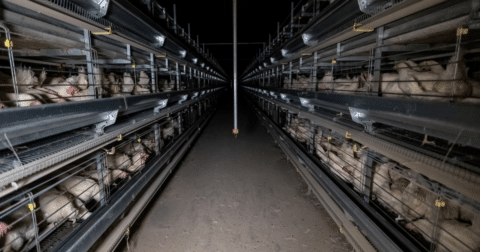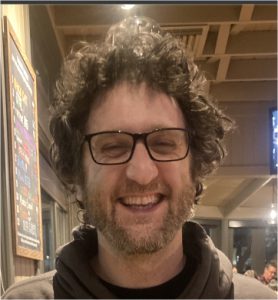News
Costco Chicken Processing Plant Keeps Failing Tests for Salmonella
Food•5 min read
Explainer
Most of the meat we consume comes from animals raised on CAFOs.


Words by Seth Millstein
An estimated 99 percent of farm animals in the U.S. live in what the government calls Concentrated Animal Feeding Operations, or CAFOs. But what exactly makes something a CAFO, and are they the same as factory farms? Generally speaking, CAFOs are large industrial facilities where hundreds, thousands or hundreds of thousands of farmed animals are densely packed in sheds or feed yards. They’re an example of what’s also called intensive farming, in which the goal is to produce the maximum amount of product using the least amount of physical space.
“They work like an industry,” John Ikerd, professor emeritus of agricultural economics at the University of Missouri, tells Sentient. “The basic characteristics of an industrial operation is to specialize. You specialize in just doing one thing, so you can do it more effectively. And once you specialize, then you can routinize the process. And once you routinize, you can mechanize, and once you mechanize, then you simplify the whole production process, so that you can consolidate into larger and larger operations.”
The argument for farming more like an industrialized factory came from agriculture researchers in the mid-20th century, according to agricultural economist Jayson Lusk, and it wasn’t seen as a bad thing. Getting bigger was a way for farms to become more efficient and, therefore, more economically sustainable. Unfortunately, that efficiency comes with a multitude of tradeoffs, for animals, workers and the environment.
The term “CAFO” was created by the U.S. government in the 1970s as part of a federal effort to reduce water pollution. It began in 1972, when Congress passed the Clean Water Act. This law authorized the EPA to regulate point source pollution, or water pollution that comes from a single identifiable source; while the law didn’t include the acronym “CAFO,” it did mention “concentrated animal feeding operations” as an example of point source pollution.
Ikerd says the amount of water pollution a farm emits is directly tied to how densely concentrated the animals on the farm are.
“If you have the animals dispersed out across the land, as they were before we had CAFOs, then you’re not concentrating the waste in one place,” Ikerd says. “When you concentrate the animals, then you concentrate the manure, and the urine and all the waste from the animals.”
In 1974, the EPA formalized and expanded upon this designation, issuing a rule that defined CAFOs as a subset of AFOs, or (non-concentrated) animal feeding operations.
The difference between an AFO and a CAFO is important, as CAFOs are subject to more stringent regulations.
The size designation of any given AFO depends on a number of factors, the primary one being the number of animals in the facility and the species of animal in question. For instance, a dairy AFO is considered large (and therefore a CAFO) if it has over 700 dairy cows; a turkey AFO, meanwhile, needs 55,000 or more turkeys to qualify as a CAFO.
There are a few other factors that determine whether a facility qualifies as a CAFO. With pig farms, the weight of the animal is taken into consideration. On chicken farms, the size designation depends on whether the birds are being farmed for meat or eggs.
There’s another important factor in determining whether or not a farm qualifies as a CAFO, and that’s the manner in which it processes and stores manure. This is because manure storage plays a big role in determining how much water pollution a CAFO creates, and managing water pollution was the government’s impetus for coining the term “CAFO” in the first place.
Each year, industrial livestock operations create a staggering amount of manure and other farm animal waste; 941 billion pounds, according to a Food and Water Watch report from 2024.
For poultry farms, the threshold to qualify as medium- or large-sized is lower if the facility uses liquid manure handling systems, as these systems are more prone to leakage, and thus polluting nearby waterways, than dry systems.
Finally, the director of the EPA has the authority to designate individual facilities as CAFOs on a case-by-case basis, should they determine that the facility in question is a significant contributor to water pollution.
Unlike “CAFO,” the term “factory farm” isn’t a legal term with a statutory definition. It’s more of a general concept that’s used colloquially to describe CAFO-like facilities.
Merriam-Webster defines a factory farm as one in which “large numbers of livestock are raised indoors in conditions intended to maximize production at minimal cost.” That’s a simpler, less specific and potentially more expansive definition than the government’s definition of a CAFO; depending on how one interprets the word “large,” it’s easy to imagine a facility that meets the dictionary definition of factory farm but doesn’t technically qualify as a CAFO.
Ikerd, however, defines “factory farm” a bit differently. He says that it’s a “farming operation that basically functions like a factory.”
“You put [the animals] into this factory-like setting, and then you apply certain routine procedures to them that are specified by the people that are contracting with them,” Ikerd says. “And then you come out with a finished product on the other end, whether that’s meat, or milk or eggs.”
According to the EPA’s latest numbers, there are 21,179 CAFOs in the United States.
Most U.S. states have at least one CAFO, but they’re not evenly distributed across the country. Iowa is home to the most CAFOs (around 4,025), and another five states have over 1,000 CAFOs in their borders. The majority of states (28) have between 100 and 1,000 CAFOs, while a small handful have under 10.
CAFOs generate an estimated 941 billion pounds of manure each year, and dealing with that manure is a major challenge for farm operators. Typically, it’s either stored on-site in a lagoon or similar structure until it can be sprayed onto nearby crops for use as untreated fertilizer.
Manure lagoons can be prone to leaks and malfunctions, especially during storms, and even a light rain can wash the fertilizer on cropland into nearby rivers, lakes and streams. This is what’s known as nutrient runoff, and it’s especially common when manure is overapplied as fertilizer, which Ikerd says is common on CAFOs.
The impacts of CAFO-sourced water pollution has severe consequences for humans, animals and the environment. Along with other pollution, it leads to harmful algae or algal blooms, an overgrowth of algae that can cause mass fish die-offs and extensive damage to aquatic ecosystems. Harmful algae blooms can also contaminate drinking and recreational water, and have been linked to at least one fatal case of paralytic shellfish poisoning in a human.
Livestock manure can also contain infectious bacteria, such as E.coli and salmonella, that can end up in the air and water nearby CAFOs, and even nearby fruit and vegetable farms.
The antibiotics that farmers administer to animals on CAFOs are also fueling the world’s antibiotic resistance problem, a public health threat that kills over one million people every year.
Facilities that meet the government’s definition of a CAFO have to abide by a few modest requirements relating to its manure and waste management.
First, any CAFO that discharges pollutants into waters of the United States — a legal term that we’ll discuss in a moment — is required to obtain a National Pollutant Discharge Elimination System (NPDES) permit. These permits place limits on the amount and type of pollutants that the CAFO in question is allowed to discharge. The EPA defines a pollutant as “any industrial, municipal and agricultural waste.”
Second, any CAFOs with a NPDES permit — and all large CAFOs, regardless of whether they have a permit — must present the EPA with a nutrient management plan. This is simply a description of the procedures the CAFO will use to manage the manure, animal parts, wastewater and other potential pollutants it produces, and ensure that they don’t contaminate nearby water in excess of the limits imposed by the NPDES.
There are some loopholes in this system. The first concerns which types of waterways a CAFO isn’t allowed to discharge pollutants into without a permit. EPA rules use the phrase “waters of the United States” (WOTUS), a legal designation created by the Clean Water Act that’s been subject to significant litigation and modification over the decades, most recently in 2023.
The nuances of WOTUS designations are incredibly complex and technical, but broadly speaking, the term covers most major and permanent waterways while excluding some smaller, unofficial and impermanent ones.
As a result, there are some CAFOs that don’t need to obtain an NPDES permit, or abide by any limits that such a permit would impose. CAFOs that discharge their waste into non-WOTUS designated waterways are exempt from permitting, and so are those whose waste indirectly ends up in waterways. This latter category includes farms that store their manure in lagoons or apply it as untreated fertilizer to crops.
This might sound like a small loophole, but it has enormous implications. According to the EPA’s own data, less than one-third of all CAFOs in the U.S. have an NPDES permit. In Iowa, the state with the most CAFOs, less than four percent are NPDES-permitted.
If CAFOs violate the terms of their NPDES permit — and they often do — the EPA can fine them. But this brings us to another problem with the regulatory framework around CAFOs: When the water is polluted, it’s tough to figure out exactly where that pollution came from.
“It’s very difficult to prove a violation, and link a violation to a particular CAFO,” Ikerd explains. “If you’ve got pollution in a stream, it’s very hard to bring that back to one particular operation. So you’ve got to go through the process of saying, ‘it came from this particular operation rather than another,’ and that’s really made it difficult to enforce.”
Some states have created their own permitting regimes for CAFOs that go above and beyond the EPA’s requirements. Oregon, for instance, allows its state environmental agency to require NPDES permits for all enclosed animal farms, regardless of their size. As a result, the state has issued more than twice as many NPDES permits as there are CAFOs within its borders.
The rising number of CAFOs in the United States are driven by a growing global population fed largely by cheap meat. But a relatively new phenomenon is emerging in communities across the United States: small groups of residents who oppose the construction of new CAFOs are working to block factory farm expansion. Some of them, like one that formed in Linn County, Oregon, are even finding success.